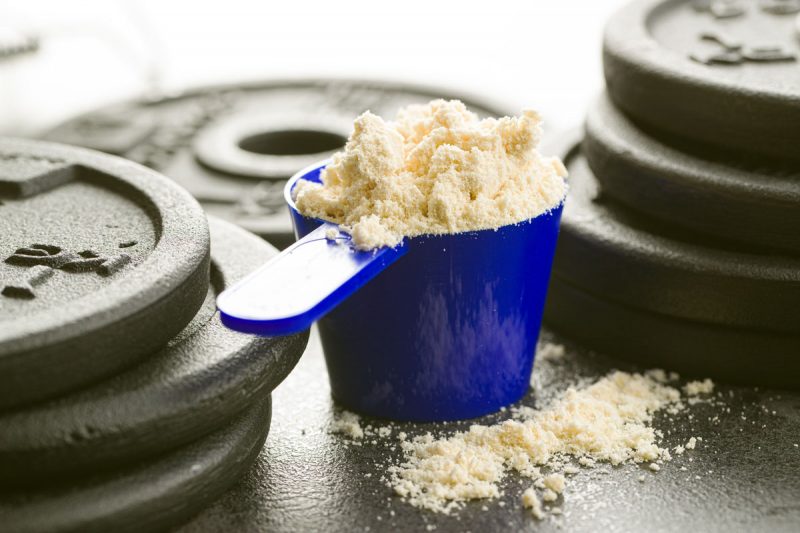When I was a younger man getting protein to fuel my workouts was challenging. It was typically wrapped in other less desirable ingredients and added flavors to compensate for bad flavor. There were only a few manufacturers and their product lines were limited. If you wanted to find these products you had to visit a health food store.
Today protein is everywhere. It has gone mainstream and is showing up on grocery shelves around the country. As we continue to discover the merits of this product in terms of muscle building and fat loss, we can expect to see even more advances.
There is no doubt that protein helps build muscle, but research indicates that different types of proteins have different benefits. Getting your protein from a variety of sources is a key consideration. Be sure to get plenty of your protein supply from food sources and supplement with powders.
Because of its popularity and potential sales power, many manufacturers have begun producing full lines of protein. With the many manufacturers and varieties of proteins available choosing one can become overwhelming. Here we offer you a quick guide to help in your decision making.
savour… fitness fuel
PROTEIN POWER
Before you start:
Protein powders are not just for bodybuilders. Most of us can benefit from it in some way. If you are unsure if it is for you, be sure to contact a health care professional.
As I have said many times in the past here, the very best way to make sure your body has a steady stream of nutrition and keep your “fat furnace” burning is to eat 5 or 6 smaller meals spread out throughout the day.
Be sure to get much of your protein needs from your diet including eggs, lean meats, and low-fat dairy products such as Greek yogurt.
Whichever protein regimen you choose, stick with it for a while. Your body will need some time to adjust and for you to see results. I would give it at least a month and up to 60 days before evaluating and adjusting as necessary.
Types of proteins
Whey proteins
This is currently the most commonly found protein. It is quickly digested and full of essential amino acids. Whey protein accounts for about 20% of the protein in milk. It comes in three common forms; concentrates, isolates, and hydrolysates.
Casein proteins
This protein makes up the other 80% of protein from milk. Because it is absorbed more slowly, it can be especially beneficial when taken at bedtime or before long periods between meals.
Milk proteins
These are essentially dried milk with much of the fat and carbs removed. They are made up of whey and casein so you get the benefit of both types.
Egg proteins
The proteins in eggs are often regarded as a top source. They have some of the highest scores in protein quality and are an excellent alternative for those with milk allergies.
Blended proteins
These are a good choice for anyone who will only be taking one type of protein. Because they are blended with several protein options you will reap some of the benefits of all the sources.
How do you choose?
You will need to know how much you will need. On average, most of us could benefit from about 1 gram of protein per pound of body weight per day. This includes the protein you get from food. If you are trying to add muscle or are following a diet higher in protein and lower in carbs and fats, you may choose to get a little more than 1 gram per pound of body weight.
You will need to know how much you are willing to spend. There are some real benefits to having several different types of proteins available for different benefits. If you have the time/money/discipline to manage different proteins for different stages of each day then invest wisely. If not, get at least one high quality blended protein to supplement as needed.
When do you take it?
Adding protein shakes as part of your daily routine can help tremendously… but when is the best time to take it. You will have to make this decision based on the rest of your routine, but remember that spreading the protein and nutrition out for the entire day is the goal. As a guideline, consider using it:
- When you wake up
- Before your workout
- After your workout
- Between meals (helps to fool your body into thinking it’s full… especially w/fiber)
- Before you go to bed (use a protein with casein for ‘slow-release’ benefit)
Reading the label
Food labels can be confusing. Labels for protein powders are no exception and due to the fact that many of the ingredients are somewhat foreign to most of us, they can be even more confusing. If you are having trouble deciphering it, purchase your protein the first time from a reputable health food store where you can speak to an expert. You will be looking for the amount of protein per serving, the other ingredients, the order of ingredients, and the number of servings per container. Once you have settled on a brand, you can purchase your protein online… many times at a drastic discount.
There are dozens of protein supplement distributors. Some manufacture the protein themselves while others just package and market someone else’s product. Be sure what you are getting, and choose a trusted source.
We hope you have found this article helpful. If you have further comments or questions, as always, please feel free to leave them after the post.









